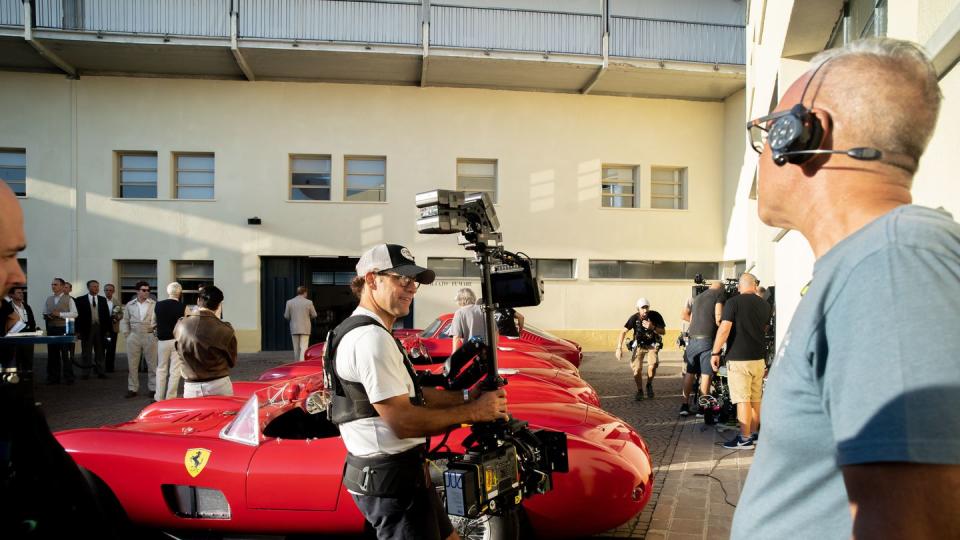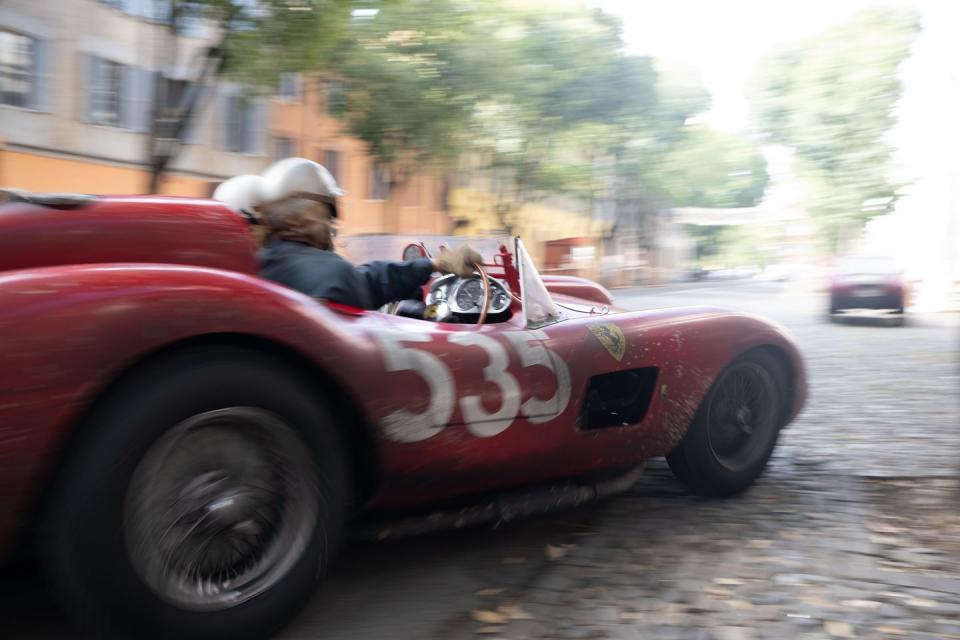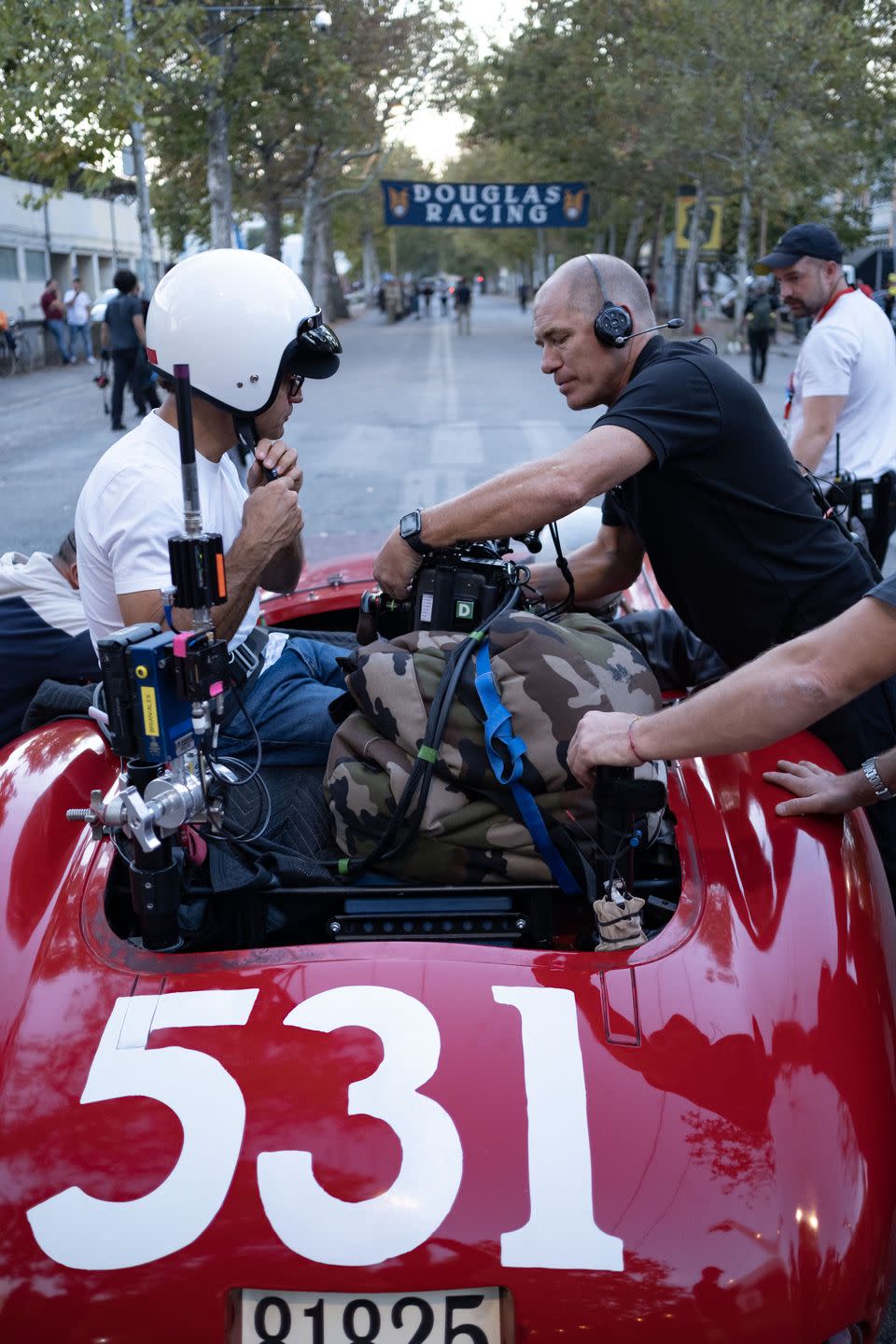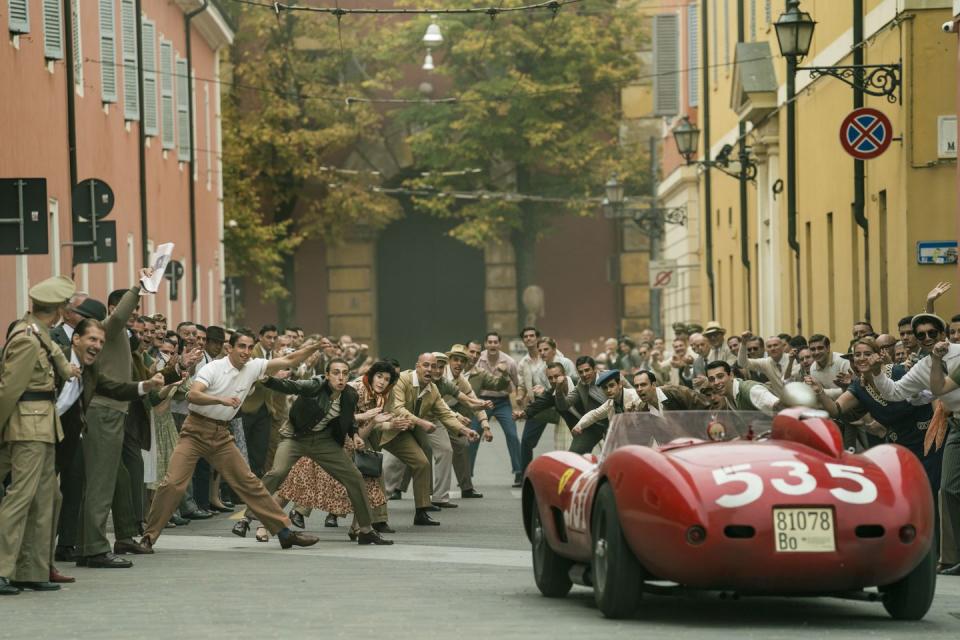The Cars of Michael Mann's 'Ferrari'

There is a rhythm to racing movies. At their heart, they all ask the same question: What drives drivers to drive, or, in the case of Michael Mann's Ferrari, what drives Adam Driver (as Enzo) to drive drivers to drive?
Racing films tend to be masculine tales well marbled with tragedy, the history of racing being undeniably macho and often fatal. Cinema fans familiar with Mann's oeuvre will easily see the appeal that Ferrari's story held for a director whose work (Heat, Thief, The Insider, Ali, Miami Vice) highlights men faced with an external enemy, whose existence highlights their internal turmoil and threatens their sense of self. In Ferrari, Mann eschews the usual sweeping scope of a biopic and focuses on a single year, a time when Enzo's personal and professional achievements were all in danger of collapse. It's more a film about life choices than cars, but where there are cars, they are glorious, so we sat down with vehicle supervisor Neil Layton, stunt coordinator Robert Nagle, and Michael Mann to find out how they recreated mid-century Ferraris on film. Here's where you can read our movie review.
Robert Nagle: Revving Up
If a movie comes out with cars going quick, it's likely Robert Nagle had a hand on the wheel. Nagle, a stunt coordinator based in Los Angeles, California has organized or participated in the driving thrills of Ford V Ferrari, Black Panther, Baby Driver, John Wick, and most of the Fast & Furious series. His relationship with Mann goes back two decades, and he's been in discussion with the director about making a Ferrari movie for that entire time. "I think the studios were terrified of racing movies," Nagle says. "But then the success of Ford V Ferrari might have opened their minds to it."

After trying and shelving Ferrari several times, Nagle says the final call to action came quickly. "Mann sent me a script more than a year before we got started, and then I didn't really hear anything until December of 2021. I get a phone call from him, and he basically said, "Pack your bags. We're going to Italy next week." We scouted some locations, interviewed different vendors to build cars, then came home, went back in the middle of February, and stayed there through October filming the movie."
Because Nagle was familiar with previous versions of the script, and a fan of racing history in general, he says the research for building the cars and blocking the racing scenes was not so much learning the story, but all about getting little details right. "What was interesting is that those cars are all different because they're handmade. And even though two cars may have been made at the same time, they were made by different people, and there are little personalities in each one." He says the Ferrari factory was generous with its archives, sharing build sheets and log books which helped the team get the cars right both technically and spiritually. "They had records from the [Piero] Taruffi car. Who had hands on it, who built the engine, where it finished or where it didn't finish. How much fuel did it use? It was amazing. The hair on my arms is standing up now just talking about it."
For Ferrari, sourcing cars wasn't as easy as calling in some yellow Camaros from Chevy, or sticking a blower on a Dodge Charger. Barely a handful of prancing horses like the 335 S that De Portago drove in the film still exist, and when they change hands, so does some $35 million. Even more challenging are the cars that don't exist at any price, like the single seat 801 F1 seen testing in an early scene. Even if Mann did have access to the real cars, there aren't many places to hang a camera on an original 1950s roadster, and you sure don't want to send them crashing off course.

To achieve the stunts needed for the story, Mann's team had to build replicas, but not just sluggish movie cars that look fast when the film gets sped up. The driving Nagle had in mind for the movie was closer to racing than traditional stunt driving. "Most car movies, you're just going to wreck everything," he says. "It's all done at slow speeds. We needed cars that could be driven at race speed." Nagle called in the skills of Neil Layton, a British race engineer turned movie man. "Oh Neil is a unicorn," says Nagle. "What I love about Neil is he and I speak the same language. He was a crew chief for a bunch of race teams, I didn't have to explain to him what suspension geometry and bump steer were."
The stunt cars not only had to be fast, and look right in motion, they also had to be able to maintain proper handling characteristics with heavy cameras mounted in different locations, and when they crashed—because they had to crash—they needed to crumple with historical accuracy. To get the proper crinkles, Nagle tasked Italian coachbuilder Carrozzeria Campana with creating aluminum bodies to fit over Layton's team's modern engines and chassis. Wheel covers that look like drum brakes cover modern disc. Even the sound of the engines was discussed at great length. "I had a long conversation with the sound engineer to explain to them in detail how harmonics change through the RPM range. You can't just record an engine at 3000 rpm and then digitally increase the hertz. It doesn't sound right, and to go further with that, you get primary, secondary and tertiary waves that interact with each other and when you add a V-8 to a V-12, how do those frequencies interact?" The sound team was able to record several vintage racers with different engines at speed in order to match the V-8s and V-12s of the hero cars.
Neither Layton nor Nagle would give me the exact details of the chassis and engine combo they used under Campana's gorgeous metalwork, only that it was a supercharged 2.0-liter, but when I said, "Caterham?" Nagle smiled and sipped his coffee. "I can tell you that they only weighed 1800 pounds when we were done," he said. "And that they were fucking fast."

Even though Nagle says the replicas were a blast to drive, the car that stands out most to him from filming was one of the few originals, a 1957 Maserati 250F. "We had two. One was Nick Mason from Pink Floyd's car, and then we had another that the owner also runs in historic races. I got to drive that one, a $10 million car, and it blew my fucking mind. It just wanted to be driven hard, not babied. The harder I drove the car, the better it worked. It was incredible. But you couldn't use cars like that for most scenes. There's no idling around, there's no slipping the clutch. You just have to send it."

 Yahoo Autos
Yahoo Autos 